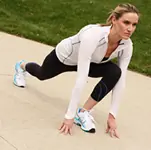One day a week, you'll have a cross-training day. This will keep your muscles moving, build strength, help with recovery, and prevent injuries. Good examples of cardio cross-training would be biking, swimming, elliptical or rowing machines.
Rest/Stretch/Weight Days
This is challenger's choice. Stretching and strength training are both important parts of your training plan. Strength training leads to stronger quadriceps and healthy hamstrings, which creates stronger knees, decreasing your chance of injury.
Adding a yoga class to your schedule can improve your flexibility and open up your hips to decrease your chance of injury.
Try to dedicate at least one day a week to weight training and stretching.
More: The Importance of Rest
Mandatory Rest Day
No matter how good you're feeling, it's essential to take at least one full day per week to completely recover. Rest is just as important as running when it comes to a good training plan.
Mile-Test Days
On day 1 and day 30, warm up for 10 minutes with easy, dynamic movement, complete your mile for time, and then recover with a 10 minutes of jog or dynamic stretching.
More: 4 Dynamic Warm-up Exercises for Runners
The Fine Print
- Always use proper running form and alignment to maximize results and prevent injury. Review this 10-point checklist to make sure you have good running form.
- It's suggested that you start the challenge on a Sunday or Monday and follow the schedule in order to the best of your ability. The running, rest and cross training days are organized in a way to allow for recovery so you can push yourself harder on interval days.
- Use your tracker to record the pace of your intervals to measure your strength and speed. Some days you may feel strong, push yourself on those days.
- Use a treadmill or pacing device to measure your speed and distance on mile-test days. It's OK to mix up terrain on certain days and incorporate hills for an additional challenge, but it's best to test your mile pace on the same flat ground.
- Be smart, listen to your body, and take a rest day when needed.
- Always speak with your doctor before you start any new exercise regimen.
Get Started
More: Take the 30-Day Ultimate Push-up Challenge
 Sign up for your next event.
Sign up for your next event.
- 2
- of
- 2
About the Author

Get ACTIVE on the Go


Couch to 5K®
The best way to get new runners off the couch and across the finish line of their first 5K.
Available for iOS | Android







Discuss This Article